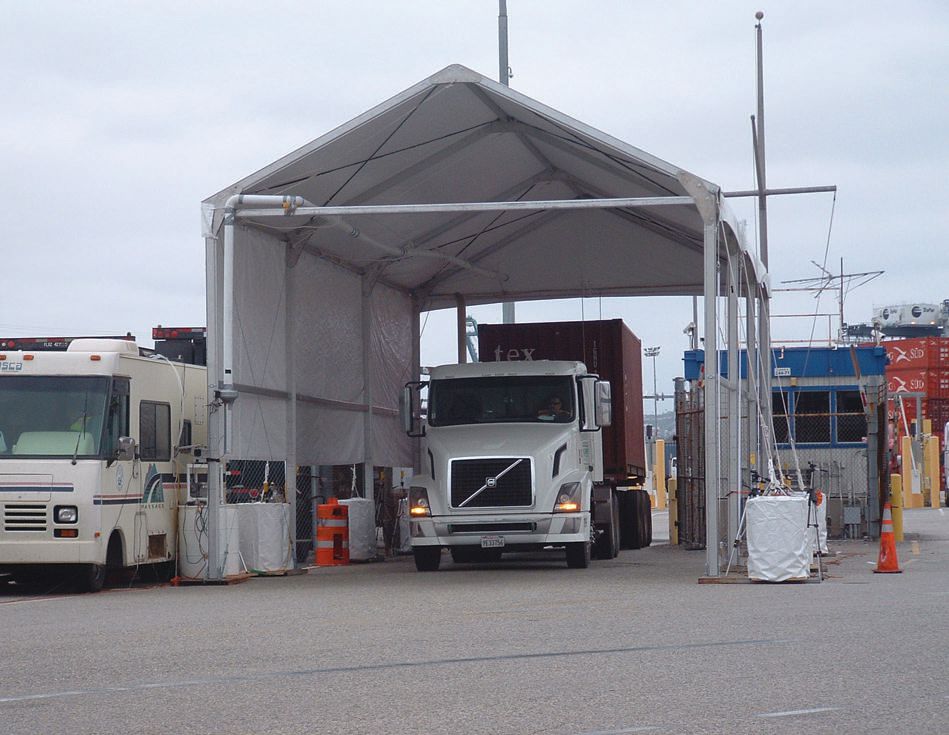New method for measuring heavy-duty vehicle emissions
Dr. Neil Canter, Contributing Editor | TLT Tech Beat April 2015
The On-Road Heavy-Duty Vehicle Emissions Monitoring System shows that emissions have continued to decline.
KEY CONCEPTS
•
A new process for measuring heavy-duty vehicle emissions measures the emission generated as a truck accelerates from a standing start or crawl through a tent.
•
Test results from two locations in California show that emissions have continued to decline in the recent past, especially for 2014 heavy-duty vehicle models.
•
Particulate emissions for heavy-duty vehicle models built since 2011 are more than a factor of 30 lower than for heavy-duty vehicles built before 2007.
VEHICLE EMISSIONS ARE STILL A CONCERN AS REGULATIONS ARE REDUCING the concentration of specific pollutants such as carbon monoxide, hydrocarbons and nitrogen oxides (NO)
x that can be emitted into the atmosphere. Measurement of these pollutants continues to be very important to determine how effectively vehicles are controlling emissions as they are used in specific locations.
Donald Stedman, Brainerd Phillipson professor of chemistry at the University of Denver in Denver, Colo., says, “Determination of pollutants in a specific location over a long period is important to gain a better understanding of how emission levels change in the same vehicles as they age.”
In a previous TLT article, work conducted by Stedman to evaluate the emissions generated at five U.S. cities over a 10-year period was discussed (
1). The key result is that the introduction of second generation onboard diagnostic systems led to a significant reduction in emissions even allowing older vehicles not to show an increase in emissions over time. Stedman indicated that when the study was published in 2008, half of vehicle emissions originate with only 3% of the vehicles.
Stedman and his associate Gary Bishop, research associate, published a new study (
2) analyzing how the U.S. recession impacted light-duty vehicle emissions in three U.S. cities in 2013. Stedman says, “We have been studying vehicle emissions in Denver, Los Angeles and Tulsa for many years and have a good understanding of the composition of the fleets in those locations.”
The reason for this study is that the age of vehicle fleets in the U.S. increased during the recession because reliability and replacement costs have both increased. Stedman says, “The age of the U.S. light-duty vehicle fleet has changed after the recession. Ten years ago the average age of the fleet was seven years. At the end of the recession in 2013, the average edge has increased to nine years.”
The researchers estimated that emissions increased at a higher rate because fleet turnover was reduced due to the recession. Emissions were 17%-29% higher for carbon monoxide, 9%-14% higher for hydrocarbon, 27%-30% higher for nitric oxide and 7%-16% higher for ammonia, respectively, than if the vehicle fleet had turned over at a rate seen before the recession.
Much of the focus in research on emission has been in evaluating light-duty vehicles. Stedman points out that most of the emissions for (NO)
x and black smoke can be attributed to heavy-duty vehicles. He says, “While heavy-duty vehicles represent only 2% of the overall fleet in the U.S., they contribute 30% of the (NO)
x and 50%-60% of the black smoke emissions.”
Current emission testing of heavy-duty vehicles is limited. Stedman says, “Test procedures such as the U.S. Federal Government dynamometer test and optical measurements can provide good data but are limited because of high cost and the lengthy test period that limits the number of heavy-duty vehicles that can be evaluated. Another concern about the optical technique is that the truck must move from a neutral position with an idling engine to then rapidly accelerate. This is, unfortunately, a way to severely damage an engine.”
A new approach is needed that will make it more convenient and economical to evaluate heavy-duty vehicle emissions. Such a procedure has now been developed.
OHMS
Stedman, Bishop and their research associates have developed a new process for measuring heavy-duty vehicle emission known as the On-Road Heavy-Duty Vehicle Emissions Monitoring System (OHMS). When participating in the test, the truck accelerates from a standing start or a crawl as rapidly as possible through a tent that is 15.2 meters long, 4.6 meters high and 5.5 meters wide as shown in Figure 2.
 Figure 2. A new process known as OHMS has been developed to measure the emissions of heavy-duty vehicles as they accelerate through the tent shown here. (Figure courtesy of the University of Denver.)
Figure 2. A new process known as OHMS has been developed to measure the emissions of heavy-duty vehicles as they accelerate through the tent shown here. (Figure courtesy of the University of Denver.)
The tent is needed to contain the emissions and prevent it from rising into the atmosphere. Air intake pipes are situated on the passenger side of the truck to absorb the emissions and pass it through a series of instruments used to measure the key pollutants.
Testing locations were established in the Port of Los Angeles and at the Cottonwood weigh station on a major interstate highway (I-5) located in Redding, Calif. Stedman says, “Measuring emissions at the Port of Los Angeles represents a good way to minimize interruptions with the truck drivers. Trucks need to come to a dead stop to fill out paperwork in entering and exiting this location. This provides us with a realistic way to evaluate emissions from on-road driving cycles.”
Test results on nearly 3,100 heavy-duty vehicles showed that emissions have continued to decline, especially for 2014 models. (NO)
x emissions for those 2014 models examined at the weigh station are 73% lower than 2010 models. Only 3% of the heavy-duty vehicles evaluated at the Port of Los Angeles exceeded expected emissions limits.
One of the main benefits in working with OHMS is the ability to make particulate measurements. The researchers found that particulate emissions in heavy-duty vehicles that were built since 2011 are more than a factor of 30 lower than heavy-duty vehicles built before 2007, which do not have diesel particulate filters.
Stedman considers the accuracy and precision of the data acquired by the OHMS to be good. He says, “The average emissions we have obtained on heavy-duty vehicles by model year is smooth data, which we would not see unless the raw data was noise free.”
The researchers wish to continue to refine the OHMS and use this test procedure to make measurements on heavy-duty vehicles in additional locations. Stedman says, “We are pleased with the initial results and hope to continue to produce data in public locations and to work with clients to evaluate their fleets in a confidential manner.”
Additional information on OHMS can be found in a recent article (
3) or by contacting Stedman at
dstedman@du.edu.
REFERENCES
1.
Canter, N. (2008), “Determining on-road emissions,” TLT,
64 (5), pp. 10-11.
2.
Bishop, G. and Stedman, D. (2014), “The recession of 2008 and its impact on light-duty vehicle emissions in three western United States cities,”
Environmental Science & Technology,
48 (24), pp. 14822-14827.
3.
Bishop, G., Raguindin, R., Stedman, D., McClintock, P., Theobald, E., Johnson, J., Lee, D., Zietsman, J. and Misra, C. (2015), “On-road heavy-duty vehicle emissions monitoring system,”
Environmental Science & Technology,
49 (3), pp. 1639-1645.
 Neil Canter heads his own consulting company, Chemical Solutions, in Willow Grove, Pa. Ideas for Tech Beat can be submitted to him at neilcanter@comcast.net
Neil Canter heads his own consulting company, Chemical Solutions, in Willow Grove, Pa. Ideas for Tech Beat can be submitted to him at neilcanter@comcast.net.